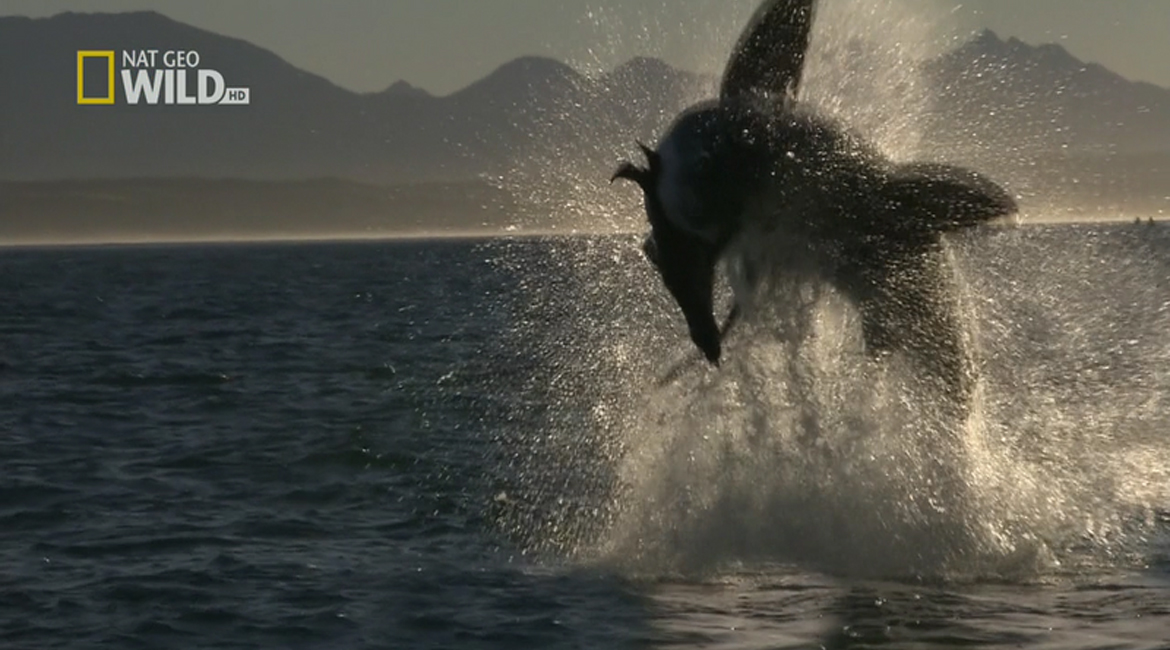
How to film the perfect Great White Shark breach attack
The Great White Shark Breach Attack
Nothing beats capturing a great white shark breach attack on camera! They explode out of the water on an unsuspecting prey in a display of extraordinary power and grace. This sequence is a favorite dream of every wildlife camera operator for very obvious reasons. Whilst 10 years ago, filming a shark breaching on a torn up carpet from a vessels deck was considered an achievement, todays camera operators are seeking new angles, new ideas, new formats to allow them to capture this incredible natural even in a new and exciting way. Having hosted over 20 film crews who have set out to capture this attack sequence, here are some of my best tips for all the camera operators out there wanting to capture this incredible event. Make sure that it can go up and compete against the BBC for pure epicness!
-
Time and place
The first thing camera operators and producers must realise is that white sharks breach in very specific places and very limited times. There are only about five places world wide where this can be readily filmed and these all occur along the southern coast of South Africa, the two most well known is our research location (Mossel Bay) and Seal Island, False Bay. These areas are small spots directly adjacent to the seal island colonies that sharks frequent. In terms of season, the sharks only readily breach in the winter, and to a lessor extent spring (May -September). This is the season when naive ‘young of the year’ seals exit the islands and make easy prey. The third point, is that white sharks require just the right light conditions to be successful. The 2-hours of dawn and the 2 hours of dusk is the only period where you can witness breaching. Get your location, season and times right and you will be set to document this spectacular event in all its glory.
-
High frame rate
The most important thing to remember is that a great white shark breach is fast, very very fast! If you are aiming for your audience to enjoy this attack, the power, speed and agility of the great white, then let them revel in it! Shooting at higher frame rates will allow you to slow your shot down and keep it as smooth as possible. Watching the epic breach attacks of BBC’s planet earth was only possible due to it being film at incredibly high frame rates. This allowed a single breach upwards of 10 seconds screen time! Naturally your camera of choice may well limit your frame rate. If, however, you are investing enough into this sequence, making sure you have the right kit is vital.
-
High resolution
Broadcast specs are ever evolving, but in todays day and age, breaching shots really need to be filmed at 4K or higher. The benefits of investing into the kit that can capture 4K are two fold. Firstly, you will be out there on a bumpy (occasionally very bumpy) boat, and thus try as you might, your shoulder mounted camera will be bouncing around. 4K gives you plenty of room to crop in and stabilize your shot in post-production. Secondly, even cropped, you are going to enjoy incredible definition that will give justice to this event!
-
Framing
Framing sounds simple, but many a camera operator has been undone by placing the towed decoy into the middle of the frame and waiting. By the time the breach is over, they then realize that most of the action was lost out the top of the frame. Place your decoy at the bottom of the frame, and realize that these sharks can spring upwards of 4m into the air! Also, if you are shooting at the higher 4K spec, then don’t be afraid to stay a little wide, as zooming in too much may cause you unintended crops if a truly acrobatic sharks breaches. Play it safe, and get the money in the bank.
-
Pre-record
Todays camera operators really have two choices, either record the entire time or utilise the pre-record function of your camera. From the perspective of a logistics host, my goal is to get as many minutes towing the decoy as possible during the small temporal window we have when breaches occur. Thus, having as little downtime as possible is always going to be the best option. From my experience, pre-record is the way to go, as this means no breaks every 20 minutes to change tapes or data cards. Whilst many a camera operator swears it will only take 20 seconds, it is incredible how many times it is during these 20 seconds that a shark chooses to launch itself from the watery depths.
-
Tow cam – in water
 This shot is a firm fave amongst camera operators, and was perfected by Charles Maxwell from Charles Maxwell underwater video services. It involved placing a tow cam a couple of metres in front of the decoy with the mounted camera looking back from underwater. If it is designed correctly you can minimize the bubbles and capture the vital second as the shark accelerates to the surface and hits your decoy.
This shot is a firm fave amongst camera operators, and was perfected by Charles Maxwell from Charles Maxwell underwater video services. It involved placing a tow cam a couple of metres in front of the decoy with the mounted camera looking back from underwater. If it is designed correctly you can minimize the bubbles and capture the vital second as the shark accelerates to the surface and hits your decoy.
-
Tow cam – out of water
An addition to the underwater tow cam is the topside tow cam. This is mounted on a slightly larger decoy (the decoy should be larger and in no way resemble a seal!) and again points back at the seal decoy. This camera can capture an incredible up-close and personal image as the shark rockets from the sea with decoy in mouth
-
Drone
To be honest, drones are difficult! Their flying time of around 15 minutes means frequent disruptions between towing (a second boat would be awesome to use), and also the wind and disruption caused by the drones propellers does impact on the frequency of breach attacks. The art is getting the drone high enough to avoid disrupting an approaching shark, and not too high to as make the shot … blah. Having a drone in which an operator can view the image real time helps massively, and if it all comes off, then it offers an incredible angle!
-
Decoy cam

A great white shark breach shot made famous by Jeff Kurr in the original ‘Air Jaws‘ documentary was the downwards shot from a camera located in the actual seal decoy. This type of shot must be used sparingly, (read 0.5seconds) as it is likely to make your audience seasick with all the bubbles shooting past. But for that split second from when the sharks appears, opens is mouth and takes the decoy (camera and all) into its mouth – this shot is sensational! A few protips, ensure that the camera is housed in something that will withstand about 600lbs of pressure, and have it separately tethered to you line to ensure it can be retrieved if the shark swims off with your decoys.
-
Your seal decoy
This is probably the most forgotten aspect of filming a white shark breach attack. Unless you are BBC and can spend a month of two going after a natural white shark breach attacks on real seals, then your filming will most likely be focussed around luring a shark to breach on a towed decoy. Even in BBC’s planet earth, attacks on decoys were the stable shot used for the great white hunting sequence. What is forgotten by most camera teams is to ensure that they bring there own decoys, or ensure that the decoy that is organized for them to use looks more like a seal and less like a piece of old carpet. Spending time in investing in a lifelike replica seal will ensure that your end footage can readily be used to replicate a natural hunt. The other aspect, is the rope used to attach the decoy to the boat. Nothing ruins a perfect shot more than a garish red rope shooting out of the water attached to the supposed seal. Buy some strong 90lb nylon for a couple of dollars, this is the best and cheapest investment you will make.
-
Lighting
 What seems obvious for most camera operators may not be obvious to your skipper operating your boat. I am talking about lighting, and more importantly ensuring that when the breach occurs your shark does not appear as a black silhouette with the sun directly behind it. Whilst this shot may be beautiful and have artistic merit, the greatest breach shots are those with the sun highlighting the sharks amazing beauty and power rather than hiding it. Whilst it is almost impossible to always position the sun correctly, ensuring that your skipper is aware and skilled to continuously try to position the boats direction to ensure your subject will be well lite, will make you very happy when the white shark breach does occur. Take time to study a contour map and work out your towing paths and where the sun will be (remembering it will be different for morning and evening tows).
What seems obvious for most camera operators may not be obvious to your skipper operating your boat. I am talking about lighting, and more importantly ensuring that when the breach occurs your shark does not appear as a black silhouette with the sun directly behind it. Whilst this shot may be beautiful and have artistic merit, the greatest breach shots are those with the sun highlighting the sharks amazing beauty and power rather than hiding it. Whilst it is almost impossible to always position the sun correctly, ensuring that your skipper is aware and skilled to continuously try to position the boats direction to ensure your subject will be well lite, will make you very happy when the white shark breach does occur. Take time to study a contour map and work out your towing paths and where the sun will be (remembering it will be different for morning and evening tows).
Naturally all this would not be possible with out getting on a boat in South Africa and getting out there and trying! So when you are planning your next big great white shark production, make sure you contact me at sharkyryan@gmail.com! I will be sure to give you the best info on where, when and how to capture this incredible sequence.


Sorry, the comment form is closed at this time.